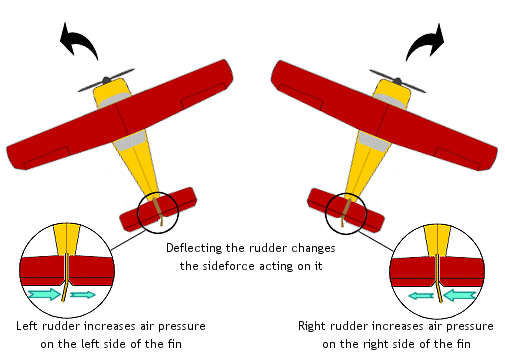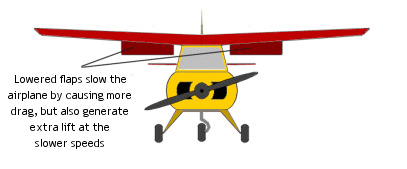Lesson 1 of your Learning to fly course is very important as it will form the basis of all your future flying and understanding the effects of the primary and secondary flight controls.
For an aeroplane to fly in control, control surfaces are necessary. The 4 main control surfaces are ailerons, elevator, rudder and flaps as shown below:

To understand how each control surface works on the aircraft, imagine 3 lines (axis – the blue dashed lines in the diagram above) that run through the plane. One runs through the center of the fuselage from nose to tail (longitudinal axis), one runs from side to side (lateral axis) and the other runs vertically (vertical axis). All 3 axis pass through the Centre of Gravity (CG), which is the airplane’s crucial point of balance.
When the aircraft is in forward flight it will rotate around each axis when movement to any control surface is made by the pilot.
Roll occurs around the longitudinal axis which is controlled by the ailerons
Pitch occurs around the lateral axis which is controlled by the elevator
Yaw occurs around the lateral axis which is controlled by the rudder

Located on the trailing edge (rear) of the wing, the ailerons control the aeroplane’s roll about its longitudinal axis. Each aileron moves at the same time but in opposite directions i.e. when the left aileron moves up, the right aileron moves down and vice versa.
This movement causes a slight decrease in lift on the wingtip with the upward moving aileron, while the opposite wingtip experiences a slight increase in lift. Due to these subtle changes in lift the aircraft rolls in the appropriate direction i.e. when the pilot moves the stick left, the left aileron will rise and the airplane will roll left in response to the change in lift on each wing.
The ailerons are controlled by a left and right movement of the control stick.
The elevators are located on the rear half of the tailplane, or horizontal stabiliser. The job of the tailplane is to generate a downward force to counteract the natural nose-diving tendency of planes, which happens as a result of the natural forces that are generated about a plane’s Centre of Gravity and Centre of Lift.
As the elevators are deflected up or down, so the amount of down force changes and this results in the airplane’s nose pitching up or down; up elevator means more down force, so the plane pitches up, and vice versa.
However, pitching the nose up doesn’t necessarily mean the plane will climb. In fact it’s quite possible to be flying level, or even descending, with a nose-up attitude. Only when power is added and speed increased, will the plane climb with up elevator.
Elevators are the single most important control surface of an aircraft, and they effect the airplane’s airspeed
The rudder is located on the back edge of the vertical stabiliser, or fin, and is controlled by 2 pedals at the pilot’s feet. When the pilot pushes the left pedal the rudder moves to the left, while depressing the right pedal deflects the rudder to the right.
The rudder works in the same way as ailerons and elevators, in that it changes the airflow over the fin.
Essentially, you can think of a fin as a vertical wing. The air flowing over it and the rudder acts in exactly the same way as it does flowing over a wing and aileron, except that the forces are vertical and not horizontal.
Deflecting the rudder to the left increases the air pressure on the left side of the fin and rudder, and so the whole back end of the plane is pushed across to the right, thus yawing the nose to the left.
Flaps are located on the trailing edge of each wing, usually between the fuselage and the ailerons, and extend downward (and often outward) from the wing when put into use. The purpose of the flaps is to generate more lift at slower airspeed, which enables the aircraft to fly at a greatly reduced speed with a lower risk of stalling. When extended further flaps also generate more drag which slows the airplane down much faster than just reducing throttle.
So, in lesson 1, effects of controls you will learn about these primary flight controls and more.



